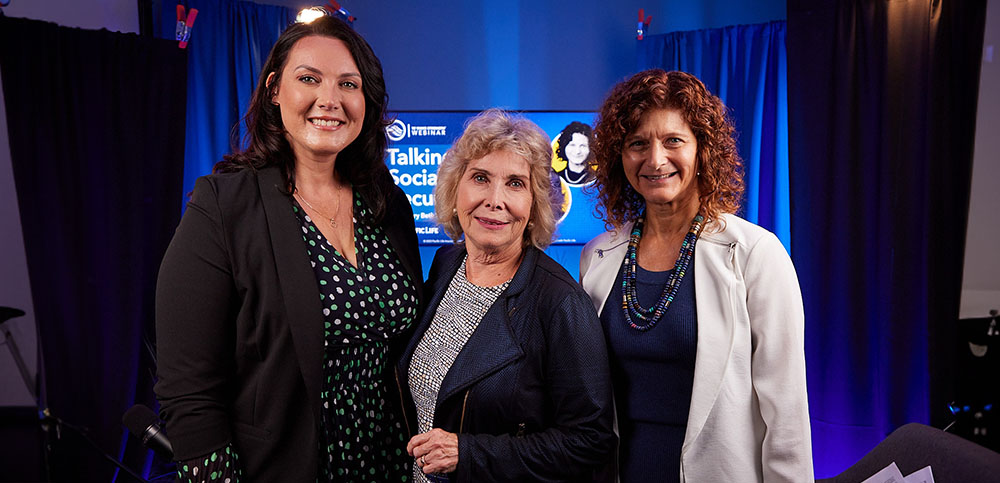This website or its third-party tools use cookies, which are necessary to its functioning and are required to achieve the purposes illustrated in our online privacy policy.
Top Takeaways
- Women and other minorities can optimize their strategies for claiming Social Security retirement benefits by keeping a few key ideas in mind.
- Life expectancy can change the applicability of some common-sense advice for certain retirees.
- Specific rules for common-law marriage and divorce can affect the claiming strategies that may work best for certain retirees.
- If you’re older than age 18, you can make a “my Social Security” account at www.SSA.gov to get important information about your Social Security record.
The life experiences of women and other minority groups are unique to their backgrounds and individual circumstances. Naturally, the same is true of their needs when planning their Social Security retirement benefit-claiming strategies.
On this episode of The Wave Strength, host Ruth Schau, Sr. Director Pension Solutions in Pacific Life's Institutional division, talks with Pacific Life’s Caroline Elrod and renowned Certified Financial Planner, Social Security expert, and public speaker Mary Beth Franklin about what women and other minorities should be aware of as they move into the Social Security-planning phases of their retirement journeys.
When to Claim Based on Life Expectancy
Traditional advice about when to claim Social Security retirement benefits usually emphasizes the value of delayed retirement credits. If retirees wait to claim until after they reach their full retirement ages, their total benefits increase by 8% for every year they delay—but the increases stop at age 70.
On one hand, it makes sense for women to take full advantage of these delayed credits, as statistics show women tend to live longer than men overall. Waiting until age 70 will ensure the largest possible retirement benefit for both the claimant and the spouse if the claimant passes away. But this advice may not be applicable to all minorities in the U.S. As Franklin says, “The sad fact is minorities in this country do not tend to live as long as many white Americans. And if you're not going to live a long time, perhaps delaying until 70 is not your best strategy.”
Of course, these decisions also must be informed by each individual’s overall health, socioeconomic status, lifetime earnings, and other factors. Even marital status has an enormous impact on when and how retirees should proceed with their claiming strategies. But at the end of the day, the most important thing is for retirees to take care of their needs. “No matter what strategies are out there, if you need the money, go ahead and take it,” says Franklin. “Even if it's a reduced benefit at age 62. And . . . you might be able to reverse that decision by withdrawing your benefits or suspending your benefits later.”
Unique Rules for Divorce and Common-Law Marriage
Many are unaware that the Social Security Administration (SSA) outlines provisions for divorced retirees that allow them to collect benefits based on an ex-spouse’s earnings record. In addition to being eligible to receive Social Security retirement benefits, retirees must be:
- Married for at least 10 years. Anything fewer than 10 years will automatically disqualify a retiree from claiming benefits from an ex-spouse. “Nine years, 11 months, and 29 days does not cut it,” Franklin says. “The only days that matter are the date of your marriage and the date of your final divorce decree.”
- Divorced for at least two years. Even if a retiree is otherwise eligible to claim benefits from your ex-spouse, he or she can’t claim until two years from the divorce date.
- Unmarried when they file their claims. If the previous two qualifications are met, retirees may claim Social Security retirement benefits from living ex-spouses if they have not remarried. But there is a provision for those with deceased ex-spouses: “If you remarry at age 60 or later, you can collect on a dead ex,” Franklin says. If you're going to take that second trip down the aisle, wait until 60 to do it.”
Some couples have nontraditional relationships with different implications when planning to claim Social Security retirement benefits. For instance, the SSA does not have federal guidelines for common-law marriages, but retirees can refer to state law for guidance. The rules for same-sex couples are slightly different, as many were together long before marriage equality was federally legalized in 2015. “There is an entire section on the Social Security webpage . . . that explains all the rights and benefits for same-sex couples,” says Franklin.
Take Control of the Planning Process Online
The one piece of information Franklin hopes to impart on her audience is simple: Familiarize yourself with the SSA website. “I think the first thing everyone 18 and older should do is go to www.SSA.gov and make sure you create a personal ‘my Social Security’ account,” she says. The process is simple, and the account will serve as retirees’ digital records of their lifetime wages, taxes paid into the Social Security and Medicare programs, and projected Social Security retirement benefit amounts.
This can be especially handy for retirees to ensure their reported wages are correct. “Everyone should be checking those records at least once a year to make sure your wages were reported correctly,” says Franklin, “because your future benefits are based on the earnings as they are reported.”
Knowledge Is Power
Regardless of their individual circumstances, retirees can never be too educated about their Social Security retirement benefit-claiming strategies. Many answers can be found on the SSA website, and retirees can always ask their financial professionals to guide them through the complexities. “We have all invested in this program,” says Franklin. “Educate yourself so we can get the most out of it.”
About Mary Beth Franklin
As a financial journalist with more than 40 years of experience and a Certified Financial Planner designation, Mary Beth writes about big-picture policy issues, such as the federal budget, tax legislation, and consumer-focused personal finance advice with a focus on Social Security. She has received numerous awards for her publications, and her work has been widely praised for helping both consumers and financial professionals build solid retirement-income plans.
About Caroline Elrod
Caroline is the manager of the Retirement Strategies Group within Pacific Life's Consumer Markets division, leading the home-office-based team. She brings more than 10 years of industry experience to her role, including experience in tax planning with insurance products. She enjoys providing retirement income-planning education—including practical strategies for business, estate, tax, and retirement-planning concerns—to financial professionals and their clients.
READ MORE

Retirement Planning
Talking Social Security With Mary Beth Franklin
Staying aware of current regulations set by the Social Security Administration can help retirees receive the full benefits they deserve.

Retirement Planning
Optimizing Social Security Benefits with Mary Beth Franklin
Women and other minorities can optimize their strategies for claiming Social Security retirement benefits by keeping a few key ideas in mind.

Retirement Planning
The Financial Pillars of Retirement with Mary Beth Franklin
Many people underestimate the importance of financial security in building an emotionally fulfilling retirement.

Retirement Planning / Family
How Annuities Can Boost Your Retirement Savings
The tax-deferred growth potential of an annuity can boost your savings for the future.

Retirement Planning / Family
How to Enhance Your Retirement Strategy with Cash Value Life Insurance
Your retirement strategy should begin with a tax-advantaged retirement account, but it doesn't have to end there. Supplementing your 401(k) or IRA with cash value life insurance can help give you greater financial flexibility during your lifetime while providing protection to your loved ones.

Family / Estate Planning
What Blended Families Should Know About Estate Planning
An estate plan with an Irrevocable Life Insurance Trust may help reduce estate taxes and ensure equitable distribution of a blended family’s assets.

Family / Estate Planning
Ensuring a Smooth Transition for Your Family Business
A plan that includes life insurance can help provide liquidity and equality in a family business succession.

Home / Estate Planning
How to Help Protect Your Estate Plan from an Uncertain Future
A life insurance trust can help provide flexibility and protection for the future.

Family / Estate Planning
Estate Planning for Unmarried Couples
Life insurance can help maximize wealth transfer for unmarried couples.

Family / Estate Planning
5 Ways Life Insurance Can Help With Estate Planning
As you develop or update an estate plan, considering the following ways life insurance can help address your needs.

Career And Business
Retirement Savings Options at a New Job
Weigh your choices before deciding where—or whether—to move your retirement savings when you switch employers.

Retirement Planning
Ways to Retire Confidently
If you’re concerned about saving enough for retirement, a protected source of income can help put your mind at ease.

Retirement Planning / Home
Don’t Put Off Saving for Retirement
Start building your nest egg early to prepare for the unexpected.

Retirement Planning / Family
Managing Your Beneficiaries’ Inheritance
An annuity with a predetermined beneficiary payout option can offer greater control without a trust.

Retirement Planning
How to Save on Charitable Giving During Retirement
Qualified charitable distributions can help with tax savings and at the same time give to charity during retirement.

Retirement Planning
Picking the Right Type of IRA for You
Understanding the difference between a traditional and Roth IRA can go a long way in planning your retirement savings strategy.

Estate Planning / Family
How to Cope Without the Family Breadwinner
Take these steps to help your loved ones prepare financially in the event the worst happens to you.

Career And Business / Family
A Smart Way for Philanthropists to Give More
A well-designed charitable remainder trust can help lower taxes and aid in financial planning.

Retirement Planning
The Challenges of Living Longer
The good news: Retirees are living longer. The bad news: That may mean retirees will have to fund more years of retirement.

Retirement Planning
Make the Most of Your Retirement With an Informed Income Strategy
Annuities offer another way to put a floor under your retirement income, providing an retirement income stream in exchange for an initial investment. Immediate annuities begin issuing payments soon after you make your investment, while deferred annuities are invested for a period of time before you start taking withdrawals. You can also choose between fixed (-rate) and variable annuities. Fixed annuities earn a guaranteed interest rate over time, while variable annuities are tied to the performance of an investment portfolio. Both provide monthly income for life and protection for your loved ones through a death benefit.

Estate Planning / Family
Finding a Way to Hand Over a Family Business
Creating a detailed succession plan is paramount for a smooth and profitable transition.

Family / Retirement Planning
Balancing the Care of Aging Parents and Children
There are ways to ease the burden of this high-stress juggling act.

Retirement Planning
Deciding When to Claim Retirement Benefits
Keys to Optimizing Social Security Income.

Home
How Tax Reform Impacts Retirement and Estate Planning
The new tax law will alter many decisions you may have to make when filing your 2018 taxes.

Retirement Planning
The Importance of Investment Diversification
Methodically placing assets in several baskets isn’t as thrilling, but helps you invest responsibly.

Estate Planning / Family
Protect Your Loved Ones With an Estate Plan
Taking a proactive approach to passing on your assets can help bring peace of mind to you and your family.

Retirement Planning / Home
Choosing a Financial Professional
When searching for the right financial professional for you, start with these 7 questions.

Retirement Planning / Family
Four Ways to Access the Value of a Life Insurance Policy
Life insurance isn’t only for your survivors: Find out how to use its cash value during your lifetime.

Retirement Planning
Women & Finances: Securing Your Retirement
Strategies to help make sure your retirement savings last for life.

Retirement Planning / Family
Women & Finances: Strengthening Your Finances After Divorce
Make sure your retirement plan is still on track.

Family / Home
Women & Finances: Moving Beyond the Loss
The loss of a significant other can offer an opportunity to learn about financial empowerment.

Retirement Planning
Weathering a Turbulent Market
Worried investors would do well to remember that historically, markets recover after a downturn.

Family / Home
The Surprising Affordability of Term Life Insurance
A life insurance policy isn’t as expensive as you think.

Family / Home
Get the Most Out of Your Annual Financial Check-Up
A yearly financial review is a good way to stay fiscally healthy.

Retirement Planning / Family
How to Buy an Annuity
Choose the right annuity plan that aligns with your financial goals.

Family / Home
6 Life Insurance Myths Debunked
Don’t let these common misconceptions prevent you from giving your family the protection they deserve.

Healthcare / Family
Planning for the Cost of Healthcare in Retirement
Trying to anticipate what you’ll spend on healthcare in retirement can seem daunting, but estimates can help you start preparing for the future.

Family / Home
The Benefits of Rethinking Work-Life Balance Before Retirement
Achieving better work-life balance now can help position you for a more fulfilling future.

Family / Estate Planning
How to Buy Life Insurance
These four steps can help you choose the best protection for you and your family.

Retirement Planning / Family
How to Lower Your Taxes in Retirement
You’ve worked hard to build your retirement savings. Now, make sure your money lasts by considering strategies to lower taxes.

Home / Family
The Importance of Financial Literacy
Learn about basic concepts regarding financial literacy: budgeting, saving, debt/spending, and financial management.

Retirement Planning / Family
Make the Most of Your Money with a Financial Plan
A financial plan can help you meet your needs today and reach your long-term goals.

Family / Home
Money Moves to Help You Feel More Confident
Build a stronger financial foundation with these four steps.

Family / Home
Supporting Multiple Generations
Tips for families with many generations living together so everyone stays financially healthy.

Family / Estate Planning
Securing Your Family’s Future
Having an estate plan is essential to maintaining your family’s financial security.

Retirement Planning / Family
4 Ways to Help Turn Income Into Wealth
Build your wealth by incorporating these strategies into your financial plan.

Career And Business
Why Employee Benefits Matter
The key to attracting top talent goes beyond trendy perks.

Retirement Planning / Family
How Much Life Insurance Do I Need?
These key factors can help you figure out your life insurance sweet spot.
Insurance products can be issued in all states, except New York, by Pacific Life Insurance Company and in all states by Pacific Life & Annuity Company. Product/material availability and features may vary by state. No bank guarantee • Not a deposit • May lose value |
Pacific Life is unaffiliated with Mary Beth Franklin. Guest speakers are solely responsible for the content of their presentations and do not necessarily represent the opinions of Pacific Life and its affiliates. The views expressed herein are those of the speaker and are subject to change at any time.
This material is provided for informational purposes only and should not be construed as investment, tax, or legal advice. Information is based on current laws, which are subject to change at any time. Clients should consult with their accounting, legal, or tax professionals for guidance regarding their specific financial situations.
Pacific Life refers to Pacific Life Insurance Company and its subsidiary Pacific Life & Annuity Company. Insurance products can be issued in all states, except New York, by Pacific Life Insurance Company and in all states by Pacific Life & Annuity Company. Product/material availability and features may vary by state. Each insurance company is solely responsible for the financial obligations accruing under the products it issues.
The home office for Pacific Life & Annuity Company is located in Phoenix, Arizona. The home office for Pacific Life Insurance Company is located in Omaha, Nebraska.
VLQ3351-0324W
